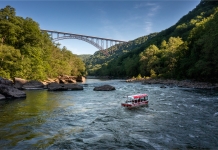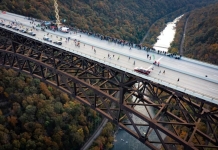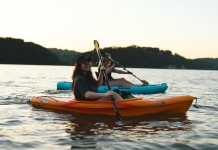Clients on commercial whitewater rafting trips won't necessarily need to review the following safety concerns. Still, private rafters and kayakers won't lose out by reviewing the following information, which applies to many West Virginia rivers and streams, regardless of their designation.
Be aware of hazards in whitewater rivers
Whitewater rivers in West Virginia contain many hazards which are not always easily recognized. Following are the most frequent sources of danger:
High Water
The speed and power of a whitewater river increase tremendously as flow increases, and this increases the level of difficulty established for most rapids in West Virginia. Rescue becomes progressively more difficult as waters rise, intensifying the danger. Floating debris and strainers can make even an easy rapid quite hazardous. It is often misleading to judge the stream level at the put-in as a small rise in a wide, shallow place may multiply many times where a river narrows. Use reliable gauge information when possible, and be aware that a hard rain, sunlight on a snowpack, and dam releases upstream may greatly increase the flow.
Cold
Cold drains a paddler's strength and decreases the ability required to make sound decisions on matters affecting safety. Cold-water immersion is especially dangerous because of the initial shock and the rapid heat loss that follows. Dress appropriately for bad weather or sudden immersion. A wetsuit or drysuit is essential when the water temperature is less than 50 degrees. The next best prevention is wool or pile clothing under a waterproof shell. In this case, you should also carry waterproof matches and a change of clothing in a waterproof bag. If, after prolonged exposure, a person experiences uncontrollable shaking, loss of coordination, or difficulty speaking, he or she may have become hypothermic and in dire need of medical assistance.
Strainers
Brush, fallen trees, bridge pilings, undercut rocks, and anything else that might allow river currents to sweep through can pin boats and boaters against the obstacle. Water pressure on anything trapped this way can be overwhelming. Rescue is often extremely difficult. Pinning may occur in fast current with little or no whitewater to warn of the danger.
Dams, weirs, hydraulics
When water drops over a obstacle, it curls back on itself and forms a strong upstream current that may be capable of holding a boat or swimmer. Some holes make for excellent sport. Others are proven killers. Paddlers who cannot recognize the difference should avoid all but the smallest holes. Hydraulics around man-made dams must be treated with utmost respect regardless of their height or river level. Despite their seemingly benign appearance, they can create an almost escape-proof trap. The paddlers only exit from the "drowning machine" to dive below the surface when the downstream current flows beneath the reversal.
Broaching
When a boat is pushed sideways against a rock by a strong current, it may collapse and wrap. This is especially dangerous to kayak and decked canoes, which will collapse, and the combination of indestructible hulls and tight outfitting may create a deadly trap. Even without entrapment, releasing a pinned boat can be time-consuming and dangerous. Throw your weight downstream towards the rock to avoid pinning, allowing the current to slide harmlessly underneath the hull.
Personal Preparendness and Responsibility
- Be a competent swimmer with the ability to handle yourself underwater.
- Wear a life jacket. A snugly-fitting vest-type life preserver offers back and shoulder protection and the flotation needed to swim safely in whitewater.
- Wear a solid, correctly-fitted helmet when upsets are likely. This is essential in kayaks or covered canoes and is recommended for open canoeists using thigh straps and rafters running steep drops.
- Do not boat out of control. Your skills should be sufficient to stop or reach shore before reaching danger. Do not enter a rapid unless you are reasonably sure you can run it safely or swim it without injury.
- Boating alone is discouraged. The minimum party is three people or two rafts.
- Have a frank knowledge of your boating ability, and don't attempt rivers or rapids which lie beyond that ability.
- Develop the paddling skills and teamwork required to match the river you plan to boat. Most good paddlers develop skills gradually, and attempts to advance too quickly will compromise your safety and enjoyment.
- Be in good physical and mental condition, consistent with the difficulties which may be expected. Make adjustments for loss of skills due to age, health, and fitness. Before starting the trip, any health limitations must be explained to your fellow paddlers.
- Be practiced in self-rescue, including escape from an overturned craft. The Eskimo Roll is strongly recommended for decked boaters who run rapids Class IV or greater, or who paddle in cold environmental conditions.
- Be trained in rescue skills, CPR, and first aid with special emphasis on the recognizing and treating hypothermia. It may save your friend's life.
- Carry equipment needed for unexpected emergencies, including foot wear which will protect your feet when walking out, a throw rope, knife, whistle, and waterproof matches. If you wear eyeglasses, tie them on and carry a spare pair on long trips. Bring cloth repair tape on short runs, and a full repair kit on isolated rivers. Do not wear bulky jackets, ponchos, heavy boots, or anything else which could reduce your ability to survive a swim.
Despite the mutually supportive group structure, individual paddlers are ultimately responsible for their own safety, and must assume sole responsibility for the following decisions:
- The decision to participate on any trip. This includes an evaluation of the expected difficulty of the rapids under the conditions existing at the time of the put-in.
- The appropriate equipment selection, including a boat design suited to their skills and the appropriate rescue and survival gear.
- The decision to scout any rapid and to run or portage according to their best judgment. Other group members may offer advice, but paddlers should resist pressure from anyone to paddle beyond their skills. It is also their responsibility to decide whether to pass up any walk-out or take-out opportunity.
- All trip participants should consistently evaluate their own and their group's safety, voicing their concerns when appropriate and following what they believe to be the best course of action. Paddlers are encouraged to speak with anyone whose actions on the water are dangerous, whether they are a part of your group or not.
Boat and Equipment Preparedness
Test new and different equipment under familiar conditions before relying on it for difficult runs. This is especially true when adopting a new boat design or outfitting system. Low volume craft may present additional hazards to inexperienced or poorly conditioned paddlers.
Be sure your boat and gear are in good repair before starting a trip. The more isolated and difficult the run, the more rigorous this inspection should be.
Install flotation bags in non-inflatable craft, securely fixed in each end, designed to displace as much water as possible. Inflatable boats should have multiple air chambers and be test inflated before launching.
Have strong, properly sized paddles or oars for controlling your craft. Carry sufficient spares for the length and difficulty of the trip.
Outfit your boat safely. The ability to exit your boat quickly is an essential component of safety in rapids. It is your responsibility to see that there is absolutely nothing to cause entrapment when coming free of an upset craft. This includes:
- spray covers which won't release reliably or which release prematurely.
- boat outfitting too tight to allow a fast exit, especially in low volume kayaks or decked canoes. This includes low hung thwarts in canoes lacking adequate clearance for your feet and kayak footbraces which fail or allow your feet to become wedged under them.
- inadequately supported decks which collapse on a paddler's legs when a decked boat is pinned by water pressure. Inadequate clearance with the deck because of your size or build.
- loose ropes which cause entanglement. Beware of any length of loose line attached to a whitewater boat. All items must be tied tightly and excess line eliminated; painters, throw lines, and safety rope systems must be completely and effectively stored. Do not knot the end of a rope, as it can get caught in cracks between rocks.
Provide ropes which permit you to hold on to your craft so that it may be rescued. The following methods are recommended:
- Kayaks and covered canoes should have grab loops of more than 1/4 inches of rope or equivalent webbing sized to admit a normal sized hand. Stern painters are permissible if properly secured.
- Open canoes should have securely anchored bow and stern painters consisting of 8 yo 10 feet of more than 1/4 line. These must be secured in such a way that they are readily accessible, but cannot come loose accidentally. Grab loops are acceptable, but are more difficult to reach after an upset.
- Rafts and dories may have taut perimeter lines threaded through the loops provided. Footholds should be designed so that a paddler's feet cannot be forced through them, causing entrapment. Flip lines should be carefully and reliably stowed.
- Know your craft's carrying capacity, and how added loads affect boat handling in whitewater. Most rafts have a minimum crew size which can be added to on day trips or in easy rapids. Carrying more than two paddlers in an open canoe when running rapids is not recommended.
- Car top racks must be strong and attach positively to the vehicle. Lash your boat to each crossbar, then tie the ends of the boats directly to the bumpers for added security. This arrangement should survive all but the most violent vehicle accident.
Group Preparedness and Responsibility
Organization
A river trip should be regarded as a common adventure by all participants, except on instructional or commercially guided trips as defined below. Participants share the responsibility for the conduct of the trip, and each participant is individually responsible for judging his or her own capabilities and for his or her own safety as the trip progresses. Participants are encouraged (but are not obligated) to offer advice and guidance for the independent consideration and judgment of others.
River Conditions
The group should have a reasonable knowledge of the difficulty of the run. Participants should evaluate this information and adjust their plans accordingly. If the run is exploratory or no one is familiar with the river, maps and guidebooks, if available, should be examined. The group should secure accurate flow information; the more difficult the run, the more important this will be. Be aware of possible changes in river level and how this will affect the difficulty of the run. If the trip involves tidal stretches, secure appropriate information on tides.
Group equipment should suit difficulty
The group should always have a throw line available, and one line per boat is recommended on difficult runs. The list may include: carbiners, prussick loops, first aid kit, flashlight, folding saw, fire starter, guidebooks, maps, food, extra clothing, and any other rescue or survival items suggested by conditions. Each item is not required on every run, and this list is not meant to be a substitute for good judgment.
Stay together on the journey
Keep the group compact, but maintain sufficient spacing to avoid collisions. If the group is large, consider dividing into smaller groups or using the "Buddy System" as an additional safeguard. Space yourselves closely enough to permit good communication, but not so close as to interfere with one another in rapids.
A point paddler sets the pace
When in front, do not get in over your head. Never run drops when you cannot see a clear route to the bottom or, for advanced paddlers, a sure route to the next eddy. When in doubt, stop and scout.
Keep track of all group members
Each boat keeps the one behind it in sight, stopping if necessary. Know how many people are in your group and take head counts regularly. No one should paddle ahead or walk out without first informing the group. Paddlers requiring additional support should stay at the center of a group, and not allow themselves to lag behind in the more difficult rapids. If the group is large and contains a wide range of abilities, a sweep Boat'' may be designated to bring up the rear.
Courtesy
On heavily used rivers, do not cut in front of a boater running a drop. Always look upstream before leaving eddies to run or play. Never enter a crowded drop or eddy when no room for you exists. Passing other groups in a rapid may be hazardous: it's often safer to wait upstream until the group ahead has passed.
Float plan
If the trip is into a wilderness area or for an extended period, plans should be filed with a responsible person who will contact the authorities if you are overdue. It may be wise to establish checkpoints along the way where civilization could be contacted if necessary. Knowing the location of possible help and preplanned escape routes can speed rescue.
Drugs
The use of alcohol or mind-altering drugs before or during river trips is not recommended. It dulls reflexes, reduces decision making ability, and may interfere with important survival reflexes.
Instructional or Commercially Guided Trips
In contrast to the common adventure trip format, in these trip formats, a boating instructor or commercial guide assumes some of the responsibilities normally exercised by the group as a whole, as appropriate under the circumstances. These formats recognize that instructional or commercially guided trips may involve participants who lack significant experience in whitewater. However, as a participant acquires experience in whitewater, he or she takes on increasing responsibility for his or her own safety, in accordance with what he or she knows or should know as a result of that increased experience. Also, as in all trip formats, every participant must realize and assume the risks associated with the serious hazards of whitewater rivers. It is advisable for instructors and commercial guides or their employers to acquire trip or personal liability insurance: An instructional trip is characterized by a clear teacher/pupil relationship, where the primary purpose of the trip is to teach boating skills, and which is conducted for a fee. A commercially guided trip is characterized by a licensed, professional guide conducting trips for a fee.
Guidelines for River Rescue
- Recover from an upset with an Eskimo roll whenever possible. Evacuate your boat immediately if there is imminent danger of being trapped against rocks, brush, or any other kind of strainer.
- If you swim, hold on to your boat. It has much flotation and is easy for rescuers to spot. Get to the upstream end so that you cannot be crushed between a rock and your boat by the force of the current. Persons with good balance may be able to climb on top of a swamped kayak or flipped raft and paddle to shore.
- Release your craft if this will improve your chances, especially if the water is cold or dangerous rapids lie ahead. Actively attempt self-rescue whenever possible by swimming for safety. Be prepared to assist others who may come to your aid.
- When swimming in shallow or obstructed rapids, lie on your back with feet held high and pointed downstream. Do not attempt to stand in fast moving water; if your foot wedges on the bottom, fast water will push you under and keep you there. Get to slow or very shallow water before attempting to stand or walk. Look ahead! Avoid possible pinning situations including undercut rocks, strainers, downed trees, holes, and other dangers by swimming away from them.
- If the rapids are deep and powerful, roll over onto your stomach and swim aggressively for shore. Watch for eddies and slackwater and use them to get out of the current. Strong swimmers can effect a powerful upstream ferry and get to shore fast. If the shores are obstructed with strainers or under cut rocks, however, it is safer to ride the rapid out'' until a safer escape can be found.
- If others spill and swim, go after the boaters first. Rescue boats and equipment only if this can be done safely. While participants are encouraged (but not obligated) to assist one another to the best of their ability, they should do so only if they can, in their judgment, do so safely. The first duty of a rescuer is not to compound the problem by becoming another victim.
- The use of rescue lines requires training; uninformed use may cause injury. Never tie yourself into either end of a line without a reliable quick-release system. Have a knife handy to deal with unexpected entanglement. Learn to place set lines effectively, to throw accurately, to belay effectively, and to properly handle a rope thrown to you.
- When reviving a drowning victim, be aware that cold water may greatly extend survival time underwater. Victims of hypothermia may have depressed vital signs so they look and feel dead. Don't give up; continue CPR for as long as possible without compromising safety.
Information sponsored by
Raleigh General Hospital

































